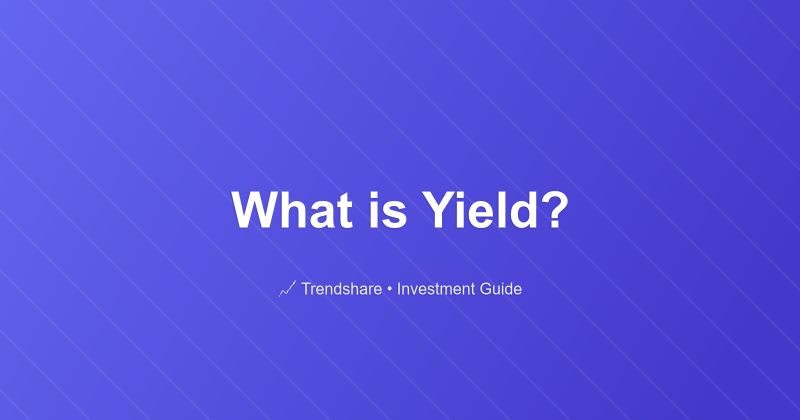
What is Yield?
By Ethan Mercer
Financial Technology Analyst • 10+ years in fintech and payments
What is yield? How measuring future income from an investment works--and why it matters.
For any investor, the most important question about any investment is "how much money can I make". Managing risk is important. So is understanding what you're buying. Yet the reason to buy a stock or bond or ETF is to make money.
Investors have multiple ways to measure the money they expect to get, depending on their investment strategies. When evaluating investments and advice, you must understand what people mean when they talk about yield, return, and types of both.
Yield is the Money Your Investment Produces
Imagine you loan a friend $1,000 for a year. She agrees to pay you back that $1,000 in twelve months, as well as $10 a month. For the loan of a thousand dollars, you'll get back the principal as well as an extra $120. Not bad!
In this simple example, you'll end up with 12% more money at the end of the year than you started with. Not bad at all!
Yield is the income you can make with an investment in a period of time. It's the cash you get from making the loan. You'll still get your principal back, but you get more coming back too.
Don't overthink this.
Bonds Have Yields
This is easy to understand with loans, where the interest rate times the principal gives you a number. It's similar with bonds, where the bond rate and payout periods determine what kind of money you get back and how often you're paid.
Bonds get a little bit more complicated because you can buy them from other investors; the yield falls as the price rises. Think of it this way: if someone else bought the loan to your friend for $1100 and the 12% interest rate stayed the same, they'd only get $20 for the year, or 1.82% interest. That's a much different yield from 12%!
Yield Depends on What You Pay
In other words, the yield depends on both the interest rate and the price you paid.
This cannot be stressed enough. If you want a higher yield, you either need to earn more money from your investment every month or pay a lower price for the investment. This should sound familiar to value investors seeking a specific rate of return.
Of course, there are different types of yield you can measure. For this to make sense, you must know how stocks produce yield.
Stocks (Can) Have Yields Too
Stocks don't pay interest, but stocks may pay dividends. If you bought Coca-Cola at $10 per share and it pays out $1 in dividends every year, you're earning a 10% yield every year. (This is the simplest to explain; it's also called a dividend yield.)
Dividend yield is easy to compare to other investments if you know what you paid for a stock, but you can't measure what everyone else paid for it. You're more likely to see the current yield of a stock, which divides the annual dividend payout with the current price of the stock.
If Coca-Cola is paying out $1 every year and it's currently trading for $20 per share, the current yield is 5%. Again, that's very different from the 10% if you'd paid only $10 per share.
What's the Difference Between Yield and Return?
Not all stocks pay dividends. You might earn a great return from an up-and-coming stock that never pays you a penny. Instead, you'll get money from selling a share for more than you paid for it. (The same goes for bonds, in fact.)
Over time, that combination of the profit you made from the sale plus any dividends you've received while you held the stock makes up your total return. Just as with yield, the price you paid is the most important factor in your return.
There's one more essential difference between yield and return. Yield looks to the future. What can you earn in a year? What dividends will you receive? What interest payments will you get? These are predictable, to an extent, depending on the risk of the investment.
Return looks to the past. Yes, it includes interest or dividend payments, but it also depends on the price at which you sold your investment.
Should You Maximize Yield or Return?
The real goal of understanding yield and return is to be able to compare similar investments to meet your investing goals. Any investment that returns money to you, regularly and predictably, can help you produce regular income from your investments. If you're trying to live off the proceeds of your investments now, that can be a great approach.
If you're trying to build wealth for the long term and don't need the money now, total return is more important. That doesn't mean you should ignore yield—it can be a great way to improve your returns. Instead, pay attention to yield but look for good returns from share price appreciation as well.
In both cases, being careful and deliberate about the price you pay for an investment will help you improve your yields and total returns.
Investment Disclaimer
This article is for educational purposes only and does not constitute investment advice. Stock prices, financial metrics, and market conditions change constantly. Company examples are provided for illustration and should not be considered recommendations. Always verify current data from official sources such as company investor relations pages or SEC filings, assess your own risk tolerance and investment objectives, and consult a qualified financial advisor before making investment decisions. Past performance does not guarantee future results.